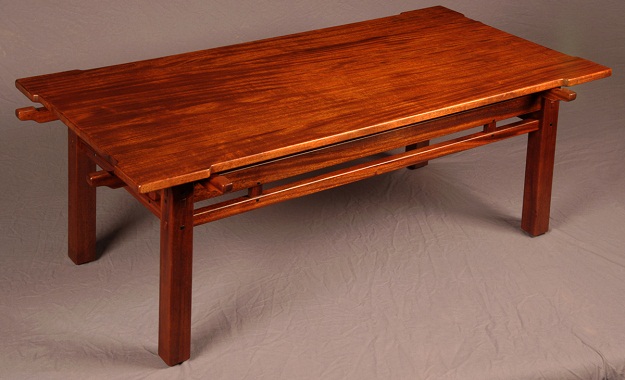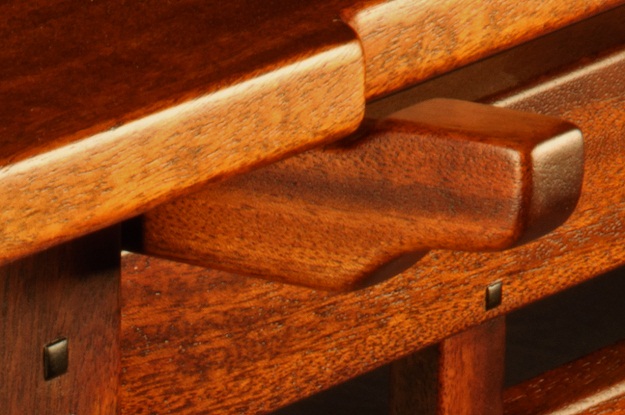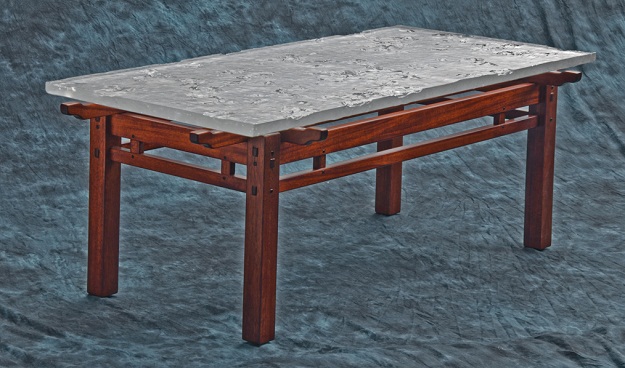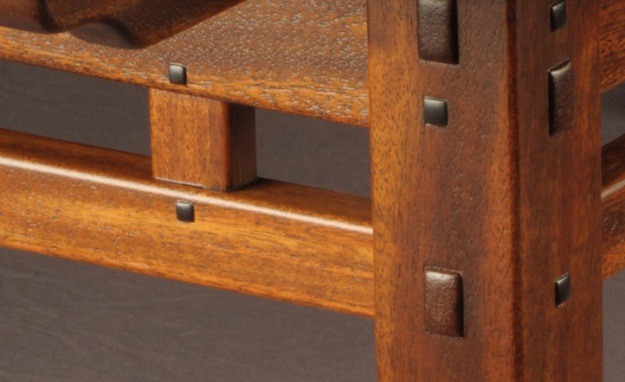We may receive a commission when you use our affiliate links. However, this does not impact our recommendations.
We had Darrell Peart in our shop a few weeks back to shoot a video, and though I was planning to write about it once the DVD was available, I certainly can’t describe it better than Darrell! (Though I will say what an honor and pleasure it was to have him visiting us for several days.)
So, we invited Darrell to share his thoughts on the “Rafter Tail Table” here on the Editors’ Blog. (For more from Darrell, see the bullet points at the bottom of his post.)
After spending many years working in the Greene & Greene style, the thought occurred to me that, “maybe I should move on.” After all, my original intention in woodworking was to study different styles, then branch out to a style of my own. So I gave myself permission to leave Greene & Greene behind.
Being a firm believer that restrictions can stifle creativity I did not, however, deny myself access to the Greene & Greene design repertoire. I set my imagination free to go where it may – be that G&G, or not!
The world that the Greene brothers created is an enticing one. No other style I have encountered is so rich with varied detail and nuance. But it’s not just the quantity of detail. Everything in the G&G universe has a purpose. Each and every element has context. Nothing is simply cut-and-paste.
In any case, I opted for a departure. Before this choice, there had been a voice in my head that said “the Greenes did not do that – so you cannot either.” That voice went away.
Reimagining G&G to include new elements and motifs has long captivated me. My “Rafter Tail Coffee Table” is one of the adaptations. Although the Greene brothers’ original designs did not include some of my rafter tail elements, I would like to think the spirit of this piece is quite at home in the G&G world.
Some of the details, such as the ebony pegs and relief (set-backs) are direct carryovers from the original Greene & Greene vocabulary. Ebony pegs are an essential part of G&G. They imply joinery and serve to visually tie structural members together. The set-backs function to highlight the elements of structure using depth. In other words, every element exists in its own plane. My rafter tail designs use these two details much as original G&G did.
Fans of Greene & Greene are familiar with cloud lifts. They are a rise in the horizontal line originally meant to portray clouds in Asian art work. The Greenes employed cloud lifts on rails (usually one at each end) or, on occasion, in some unexpected place.
The “Rafter Tail Coffee Table” does not employ cloud lifts in a typical manner. In plan view, looking down on the top, the cloud lifts are at the corners where they interact with the rafter tails. Two parallel cloud lifts sit at the very end of each rafter tail – one on the top side and one on the bottom side, forming a sort of cradle to embrace the top. Here’s a picture of that:
I sometimes imagine the rafter tail grid works as if it was a kitchen trivet. A trivet is a kitchen aid used as a buffer between a hot pot and a table or countertop. I visualize my rafter tails as a buffer between the wooden leg structure and the top. In this scenario, the top can be a variety of materials – from wood to glass or even stone.
The Greene & Greene style owes much of its success to Asian motifs. In fact, I used to describe Greene & Greene as “Gustav Stickley meets Japan.” The “auxiliary posts” and the two-part rails were not original G&G details, but to me they feel very Asian and right at home in with G&G.
I designed the “Rafter Tail Coffee Table” 100 years after the original Greene & Greene furniture appeared. Some of the details are traditional G&G. Some are of my own making. My intention was to design something that would feel at ease next to century-old pieces, but would also fit in a contemporary setting.
Buy a copy of the rafter tail project and build one for your home.
–Darrell Peart
• Darrell Peart’s blog, A Furnituremaker’s Notebook, is a great read – particularly if you love the Greene &Greene style. Here’s a link to his post “Design DNA,” for more on reimagining the G&G style.
• Read Darrell Peart’s “Regulae Stultis Sunt” (rules are for fools), the Out of the Woodwork column from the November 2009 issue of Popular Woodworking Magazine.
Here are some supplies and tools we find essential in our everyday work around the shop. We may receive a commission from sales referred by our links; however, we have carefully selected these products for their usefulness and quality.













